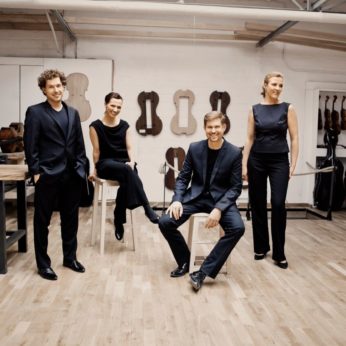Composer: Dmitri Shostakovich (b. 1906 - d. 1975)
Performance date: 30/06/2015
Venue: Bantry Library
Composition Year: 1952
Duration: 00:32:24
Recording Engineer: Richard McCullough, RTÉ lyric fm
Instrumentation: 2vn, va, vc
Instrumentation Category:String Quartet
Artists:
Signum Quartet (Kerstin Dill, Annette Walther [violins], Xandi van Dijk [viola], and Thomas Schmitz [cello]) -
[quartet]

The
Fifth Quartet was the last of Shostakovich’s quartets written in the Stalinist
era and it had to join the queue of other works that would not be given their
first public performance until after Stalin’s death. It is one of the most
uncompromising and disturbing of the quartets, particularly in the gritty
opening Allegro. This movement is
dominated by a motto theme that appears in the opening bars. It is almost
immediately brushed aside by the much more forceful first subject, but it keeps
on insidiously reinserting itself in the argument, even to the extent of acting
as a counter-subject at one of the many climactic moments. This is very much a
new sound world in the quartets, with driving rhythms allied to massive
textures and a monstrous power. There is a dreamily lyrical second subject that
does not get much of a chance to establish itself until just before the long
transition to the second movement.
The
three movements are played without a break and these transitions are engineered
with great care. After the final appearance of the second subject there is a
long pizzicato-led section where the first violin borrows a theme from
Ustvolskaya’s Clarinet Trio before climbing up to a sustained F, which is held
until the Andante theme creeps in.
Here the music attains an unusual peace, untainted by the sorrow of the times.
Again we are led into a new muted sound world, where he seeks to recreate the
mood at the end of Mahler’s Das Lied von
der Erde, the music of eternity. He was apparently particularly taken by
the sound of the celesta at that point of Mahler’s score.
For
the lead-in to the amazing Finale,
the music gradually slows to near stillness and then a sustained chord creates
the actual transition. The introductory Moderato,
with a wistful melody from the second violin, retains the peacefulness of the
previous movement, before the dancing
Allegro finally breaks in, slowly growing in intensity. This movement is on
the same scale as the first movement, but with a less dense textural argument.
Themes from both the earlier movements are allowed to intrude breaking up the
momentum and it is the gentle introduction to the Finale that has the last word, guiding the music to peacefulness in
an extended and consolatory coda.
Copyright © 2024 West Cork Music. All rights reserved.
Designed and developed by Matrix Internet